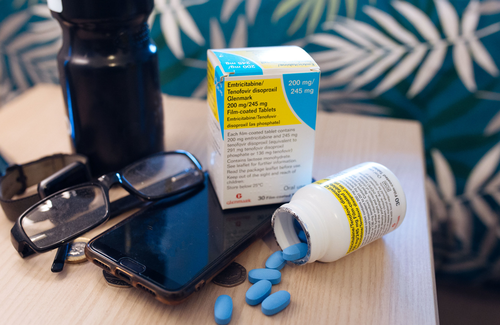
A study of people prescribed pre-exposure prophylaxis (PrEP) over a four-year period at a large centre in Los Angeles has found that HIV incidence in people taking PrEP was more than 95% lower than among service users who discontinued PrEP, and at least 92% lower than among the clinic population in general.
These are important figures because they give estimates for the effectiveness of PrEP within a community setting. We have had randomised controlled trials such as PROUD, which reported significant effectiveness for PrEP compared with a control group, and we had had reports of very low or no infections among active users in rollout programmes, but without any comparison group. This study, by comparing users with non-users, gives an estimate for the ‘real-world’ effectiveness of PrEP in individuals engaged with PrEP services.
However, it also found that only 42% of those who had been prescribed PrEP during the four years were still on it at the end of the study, and that nearly half (46%) of people prescribed PrEP had at least one period where they had either run out of PrEP or were using it intermittently. Intermittent PrEP use is not recommended by the US Food and Drug Administration, so users may not have opportunities to talk to prescribers about it, or about how to overcome “barriers to continued access,” as the authors comment.
The study
The study was conducted among people who attended the HIV and sexual health clinic at the Los Angeles LGBT centre, which sees 19,000 people a year. From the start of 2014, when the centre started providing PrEP, to the end of 2018, 3121 people initiated PrEP. Uptake accelerated over time: only 50 people (2% of the 3121 who started PrEP) did so in 2014, 18% did in 2015, 37% in 2016 and 48% in 2017.
Most people who started PrEP were cisgender gay men (94%) but 4% (111 people) were transgender women, with smaller number of cisgender women (26 people), transgender men (18) and genderqueer/nonbinary (23).
Their median age was 32, with only 14% under 24. The ethnicity of PrEP users roughly reflected the population in the Los Angeles area, though with a bias towards non-Hispanic white users. Forty-three per cent were non-Hispanic white (compared with 30% of the general population), while 31% were Hispanic (compared with 47% of the general population). Eight per cent were black and 8% Asian, slightly fewer than in the general population.
Insurance status influenced whether people discontinued PrEP.
More than half of PrEP recipients received it through one or other federal or state-supported programmes. Thirty per cent had insurance through Medicare or its state extension, Medi-Cal, which provide health cover for people over 65, people with disabilities and certain categories of people on low incomes. Another 22% had their PrEP paid for by one of two public health programmes: the California Office of AIDS or the Los Angeles County HIV and STD Prevention Program.
Thirty-eight per cent used private insurance, generally employer-provided, and the other 11% (329 people) had no insurance and paid for PrEP in some other way, usually out of pocket. As we’ll see below, people’s source of PrEP funding affected their vulnerability to HIV infection.
HIV infections and PrEP effectiveness
Fourteen people who started PrEP acquired HIV. Ten of these had discontinued PrEP before their diagnosis: the definition of discontinuation was that the person failed to collect another prescription within 22 days of what would have been their last day of PrEP, had they taken it daily. This was to allow leeway for intermittent use. All of the ten who discontinued had stopped PrEP for more than a month before they tested HIV positive.
One of the 14 tested HIV positive at his first PrEP visit and never received it. Of the other three, defined as still being on PrEP, one was diagnosed on his second visit and was thought to have had acute HIV at his first. One reported having missed more than a week’s doses in the period immediately before he tested positive. The third was definitely on PrEP when he tested positive but was thought to be a missed diagnosis; he had had two periods of missing PrEP for 3-4 weeks over a year before and had acquired HIV then, but “due to irregularities in testing procedures” his diagnosis had been missed.
What this means is that HIV incidence in the three regarded as being on PrEP was 0.1% a year, compared with 2.1% a year in those who had discontinued – a 95% reduction in incidence. HIV incidence among all patients at the centre, whether on PrEP or not, declined from 2.8% a year in 2014 to 1.3% in 2017, implying a 96% to 92% reduction in incidence among PrEP users compared with the entire clinic population.
PrEP discontinuations and insurance status
As reported above, 42% of people were still receiving PrEP at the end of the study on 31 December 2017. Twenty-four per cent had definitely discontinued, but 33% were lost to follow-up, which means some could be accessing PrEP elsewhere. Among the 1314 with a current PrEP prescription at the end date of the study, 63% had had at least one gap of 22 days or more between PrEP prescriptions.
Younger people (aged under 25) were 2.8 times more likely to discontinue PrEP, and people aged 40 or less 1.6 times more likely. Homeless or unstably housed people were over twice as likely to discontinue.
Insurance status also influenced whether people discontinued PrEP. Compared with people on Medicare/Medi-Cal or one of the public health schemes, people with private/employers’ insurance were 1.6 times more likely to discontinue and people with no insurance at baseline, 4.5 times more likely.
This adds significance to the recent announcement that the body that issues prevention recommendations in the US has now given PrEP its top priority rating, which should mean that people with private insurance will no longer have to contribute co-payments if they want PrEP, or negotiate bureaucratic hurdles to recoup them.
The authors comment: “To our knowledge, our study is the first to describe prescription coverage preceding seroconversion [HIV infection] in a community-based sample.”
They urged more support for people who need PrEP but may have problems accessing or using it regularly, and more social work support for people with disadvantages such as homelessness or insecure residency status.
They also add that the regular three-month check-ins and tests at clinics may be a burden for some and “may not precisely capture the ways people use PrEP” – in particular, people’s use of PrEP to cover “seasons of risk”, which is under-researched.
Shover CS et al. Mind the gaps: prescription coverage and HIV incidence among patients receiving pre-exposure prophylaxis form a large federally qualified health center in Los Angeles, California. AIDS and Behaviour, early online publication. doi: 10.1007/s10461-019-02493-w. See abstract here. 2019.

